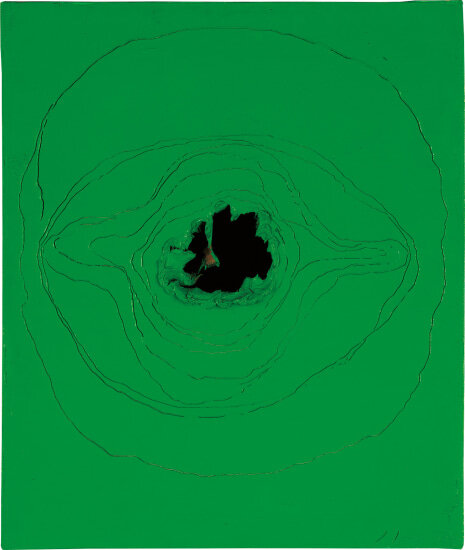Lucio Fontana, Concetto spaziale, 1964
Lot 110. Lucio Fontana, Concetto spaziale, signed "l. fontana" lower right; further signed and titled "l. fontana "Conzetto Spaziale"" on the reverse, oil on canvas, 21 5/8 x 18 1/8 in. (55 x 46 cm.) Executed in 1964. Estimate $400,000 - 600,000. © Phillips
Provenance: Galerie Burén, Stockholm
Private Collection, Malmö
Sotheby's, London, December 5, 1985, lot 310
Gallery Art Point, Tokyo
Private Collection, Tokyo (acquired from the above).
Exhibited: Tokyo, Tama Art University Museum, Lucio Fontana, Spatial Conception, 1990, no. 62, p. 66 (illustrated)
Tokyo, Mitsukoshi Museum of Art; Museo Municipale d'Arte di Kagoshima; Nishinomiya, Museo d'Arte Otani, Lucio Fontana, La penetrazione dello spazio, April 4 - November 23, 1992, no. 27, p. 66 (illustrated).
Literature: Enrico Crispolti, Fontana Catalogo Generale, Volume secondo, Milan, 1986, no. 64 O 20, p. 484 (illustrated)
Enrico Crispolti, Lucio Fontana, Catalogo ragionato di sculture, di pinti, ambientazioni, Tomo II, Milan, 2006, no. 64 O 20, p. 678 (illustrated)
"The discovery of the cosmos opens up a new dimension, the Infinite, so I make a hole in the canvas, which was the basis of all the arts, and I have created an infinite dimension.” - Lucio Fontana
Created at the height of Lucio Fontana’s groundbreaking career, Concetto spaziale, 1964, viscerally confronts the viewer with one of the most iconic and iconoclastic gestures of post-war art. Gouging and clawing into the canvas, Fontana here introduces the void into the green picture plane – enlarging it with his own hands and building up the vibrant oil paint into sculptural impasto around the opening. A quintessential example of Fontana’s celebrated olii series, the present work vividly demonstrates how Fontana pushed the medium of painting into new conceptual pastures.
It was in 1947, not long after the first photos of Earth taken from a rocket appeared around the world, that Fontana founded the movement of Spatialism in his quest for an art apt for the burgeoning space age. Repudiating the illusory space of traditional easel painting, Fontana embraced the creative force of destruction to unite color and form in real space. The violation of the pictorial plane was a profoundly conceptual act for Fontana, his radical gestures enforcing the idea of the painting as an object, and not solely as a surface. Fontana’s radical gesture of puncturing the canvas with buchi (“holes”) in 1949 ushered in a series of experiments that he collectively entitled Concetto spaziale (“spatial concept”). Fontana, who was a sculptor by training, pushed the central tenets of his buchi into the sculptural realm with his olii starting in 1957 – the introduction of oil paint into his practice allowing him to engage with the plastic nature of painting to a greater degree.
In many ways, the olii represented the antithesis of the tagli (“cuts”) that Fontana had started in the mid 1950s. In contrast to the precise slashes rupturing flat, minimalist surfaces of his tagli, the olii present heavily built up, richly textured landscapes charged with a visceral energy heightened by Fontana’s deliberate choice of vibrant hues, ranging from bright greens, pinks and gold. “The cuts that I have made so far represent above all a philosophical space,” Fontana explained. "But that which I am seeking, now, is no longer philosophical space but rather physical space… It is a human dimension that can generate physiological pain, a terror in the mind, and I, in my most recent canvases, am trying to give form to this sensation” (Lucio Fontana, quoted in Grazia Livi, "Incontro con Lucio Fontana", Vanita, no. 13, Autumn 1962, p. 55).
Created three years after Yuri Gagarin had become the first man to view earth from space through the window of his Vostok 1 capsule in 1961, Concetto spaziale presents the viewer with a rich topography pulsating in saturated green. "The color of the grounds of these canvases is a bit loud,” Fontana explained, “[indicating] the restlessness of contemporary Man. The subtle tracing, on the other hand, is the walk of Man in space, his dismay and fear of getting lost…” (Lucio Fontana, quoted in Pia Gottschaller, Lucio Fontana: The Artist’s Materials, Los Angeles, 2002, p. 90). While the lines Fontana incised into the wet oil paint around the void echo Gagarin's journey into the uncharted depths of the universe, the circular shape at the same time also suggests birth, regeneration and the cosmos - an association Fontana explored further in the egg-shaped canvases of his concurrent Concetto Spaziale, La fine di Dio series from 1963 and 1964. Concetto spaziale attests how Fontana radically probed the existential complexities of the modern age through the materiality of painting. Created in 1964 at a jubilant moment in Fontana’s career, it speaks to the remarkable vision of an artist who within just 15 years changed the course of art history forever.
Phillips. 20th Century & Contemporary Art Day Sale Morning Session, New York Auction 13 November 2019

/https%3A%2F%2Fprofilepics.canalblog.com%2Fprofilepics%2F1%2F0%2F100183.jpg)
/https%3A%2F%2Fstorage.canalblog.com%2F03%2F02%2F119589%2F96711876_o.jpg)
/https%3A%2F%2Fstorage.canalblog.com%2F11%2F31%2F119589%2F94773502_o.jpg)
/https%3A%2F%2Fstorage.canalblog.com%2F20%2F83%2F119589%2F94772815_o.jpg)
/https%3A%2F%2Fstorage.canalblog.com%2F26%2F72%2F119589%2F75604929_o.jpg)
/https%3A%2F%2Fstorage.canalblog.com%2F59%2F60%2F119589%2F26458628_o.jpg)



/image%2F1371349%2F20240313%2Fob_3da818_431115881-1632814154155264-57534444325.jpg)
/image%2F1371349%2F20240312%2Fob_cc9c83_f2.jpg)
/image%2F1371349%2F20240311%2Fob_2edda2_fontana.jpg)
/http%3A%2F%2Fstorage.canalblog.com%2F86%2F67%2F119589%2F129815803_o.png)